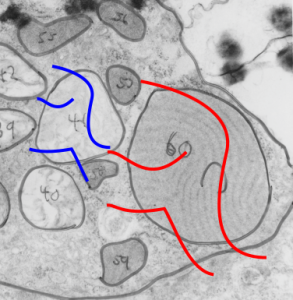Alveolar type II cell RER granule and adjacent lamellar body from a ferret, in this case untreated, a block from peripheral lung makes a pretty interesting statement. Not withstanding the bad electron micrograph, and my writing from 35 years ago, at the very moment of encountering this image I was wondering to myself, and creating a spreadsheet, about the impetus for this protein to form circular, and linear, and u-shaped patterns within the RER profile, and side by side, was a lamellar body which had similar configuration. Yes, fixation is not what could be seen in today’s labs, but it was what was recommended in the 1980s, but the similarity of the lines is pretty much an indication of something besides chance. In retrospect, the same variations seen in sections of lamellar bodies are seen in these intracisternal proteins: linear exterior, mostly linear protein banding, round exterior (just like lamellar bodies) concentric banding), U-shaped exterior, semi-curved banding. some times banding branching, or forming x or y shapes. It is not difficult to suspect that some membrane forces are at work in the formation of these similar shapes. Not my area of expertise, but certainly obvious here. This image is neg 6598_block_23139_ferret #11 untreated. Red lines flow across the pattern of layering in the alveolar type II cell granule, and blue lines flow with the direction of lamellae in the lamellar body adjacent to it. Grey outlines are left over from morphometric studies for a different purpose (sorry about those, but I didn’t take time to rub them off). If you need a measure…. the layers, or bands in the granule (labelled C) are just over 100 nm because the section is tangential, otherwise bands would be at 100 nm.
